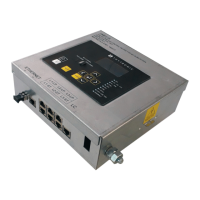45
SME2-IS - Manual - 06- 2021
FUNCTIONAL CHARACTERISTICS
— Automatic reclosing (79)
Operating logic
A variety of reclosing sequences can be set, corresponding to:
• Rapid reclosing,
• Rapid reclosing followed by slow reclosing,
• Rapid reclosing following slow reclosing and one or more memorized reclosings (0...3).
The reclosing sequence is launched following tripping of the 51.S2, 51.S3, 67.S1, 67.S2 and 67.S3
protection functions with breaker opening.
Rapid reclosing
The gure below shows a successful rapid reclosing; no fault resulting in breaker opening during
the neutralisation time.
The automation returns to standby once the neutralisation timer has counted down (default 70 s), and
a successive trip will activate rapid reclosing again.
The gure below shows a rapid reclosing followed by a fault resulting in breaker opening during the
neutralisation time. With the rapid reclosing program (79 Mode = Rapid), any trip within the time t
r
opens the breaker, blocks reclosing and issues an unsuccessful reclosing signal. The unsuccessful
reclosing signal is issued and reclosing is blocked; the automation returns to standby after the neu-
tralisation time which follows a condition of breaker closed with no fault.
Rapid reclosing and slow
reclosing
The gure below shows a rapid reclosing followed by a fault resulting in breaker opening during the
neutralisation time.
A slow reclosing is actuated after a programmable time t
sdt
(default 30 s); if no faults occur during the
neutralisation time, the slow reclosing is successful and the automation returns to standby.
Neutralisation timer
t
Successful rapid reclosing
t
Neutralisation timer
Failed reclosing
Rapid reclosing followed by fault
CB CLOSED
CB CLOSED
CB OPEN
CB OPEN
CB CLOSED
t
rdt
CB State
t
t
sdt
Neutralisation timer
t
r
t
r
t
d1
Rapid reclosing followed by fault and subsequent successful slow reclosing

